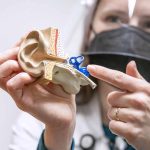Hearing loss is a common condition that affects millions of people worldwide, yet advances in hearing aid technology continue to transform lives each year. As we move into 2026, the world of hearing solutions is brimming with innovative features, smarter devices, and more personalized care than ever before. Whether you are exploring options for yourself or a loved one, understanding the latest breakthroughs can help you make the most informed decision possible. Here’s a look at what’s new in modern hearing aid technology for 2026—and how these changes can empower better hearing health.

Content
The Evolution of Hearing Aids
Hearing aids have come a long way from the bulky, analog devices of the past. Today’s models are sleek, nearly invisible, and packed with powerful digital technology. The core goal remains unchanged: to help people with hearing loss connect more fully with the world around them. However, the strategies and tools used to achieve this have seen a quantum leap.
In 2026, hearing aids are not just amplification tools—they are sophisticated, miniature computers designed to adapt to a user’s unique listening environment and preferences. Let’s explore the most significant advancements shaping the future of hearing health.
1. Artificial Intelligence and Machine Learning
One of the most exciting trends in hearing aid technology this year is the integration of artificial intelligence (AI) and machine learning. These smart algorithms allow devices to learn from your listening habits and environments, making real-time adjustments for optimal sound quality.
For example, if you frequently attend busy social gatherings, your hearing aid can recognize and prioritize speech in noisy settings. AI also helps reduce background noise, suppress feedback, and even distinguish between different speakers. This results in a more natural listening experience and less effort for the brain—a crucial benefit for cognitive health.
2. Enhanced Connectivity
The ability to connect seamlessly to smartphones, TVs, and other devices has become a standard expectation for modern hearing aids. In 2026, Bluetooth Low Energy (BLE) Audio is transforming the way users interact with their devices. This new standard offers improved sound quality, lower power consumption, and the capability to connect to multiple devices at once.
What does this mean in everyday life? Users can stream phone calls, music, and even GPS directions directly to their hearing aids with minimal lag and crystal-clear audio. Many manufacturers also offer companion apps, enabling wearers to fine-tune settings, track battery life, and access support all from their smartphones.
3. Rechargeable and Eco-Friendly Designs
Gone are the days of frequently changing tiny, disposable batteries. The latest hearing aids feature long-lasting, rechargeable batteries that can power devices for days on a single charge. Many models come with portable charging cases, ensuring users never have to worry about running out of power on the go.
This green shift is not only convenient but also environmentally responsible. Fewer batteries mean less waste, aligning with a global push towards sustainability in healthcare technology.
4. Advanced Sound Processing
2026 hearing aids leverage faster processors and advanced microphones to deliver clearer, more precise sound than ever. Directional microphones can focus on the person speaking in front of you while suppressing unwanted background noise. Some models even feature “binaural” processing, where devices in both ears communicate with each other to create a 3D audio landscape. This is especially helpful for locating where sounds are coming from, making conversations in busy places more manageable.
5. Health and Wellness Integration
Hearing aids are increasingly becoming multi-functional health devices. Many models now include sensors that track physical activity, monitor heart rate, and even detect falls. This data can be shared with healthcare providers, supporting overall wellness and early intervention for potential health issues.
For older adults, this integration offers peace of mind—providing both improved hearing and a safety net for common health concerns.
6. Personalized Hearing Experiences
Everyone’s hearing loss is unique, and so are their daily routines and listening environments. The latest hearing aids offer personalized profiles based on a wearer’s lifestyle, preferences, and the results of their hearing tests. Through regular usage and feedback, the device “learns” and adapts to better suit its user over time.
Some hearing aids even allow users to create custom sound environments—think “Restaurant Mode” or “Cinema Mode”—that can be activated with a tap or voice command.
7. Discreet and Stylish Options
Aesthetic considerations are more important than ever. Manufacturers recognize that discreet, comfortable, and stylish hearing aids can reduce stigma and encourage consistent use. In 2026, expect to see ultra-slim behind-the-ear (BTE) models, completely-in-canal (CIC) devices, and a variety of color choices to match personal style.
For those who want their devices to be virtually invisible, custom-fit options are now more comfortable and effective than ever before.
The Role of Professional Fitting and Services
While hearing aids are more advanced and user-friendly, achieving the best results still depends on expert guidance. Proper hearing aid fitting and services are essential for maximizing comfort, sound quality, and device longevity. Professionals can conduct thorough hearing assessments, customize device settings, and provide ongoing support to ensure your hearing aid evolves with your needs.
Regular check-ins and adjustments also help users take full advantage of all the new features, ensuring their hearing technology continues to deliver the best possible performance as their hearing profile changes.
Looking Ahead
The future of hearing aid technology is bright—and 2026 marks another leap forward in the pursuit of natural, effortless hearing. From AI-powered sound processing to smarter connectivity and health monitoring, today’s devices do far more than just amplify sound; they enhance quality of life.
If you or a loved one are considering updating your hearing solution, now is the perfect time to explore what’s new. Consult with hearing professionals who can guide you through the latest innovations and provide tailored hearing aid fitting and services to help you thrive in every conversation and connection.
At Health Synonyms, we believe that better hearing leads to better living. Stay tuned as we continue to cover the latest in hearing health and technology, empowering you to make sound choices for your well-being.

Anna Leake is a health blogger that focuses on topics related to nutrition, fitness, and mental health. She was born in New York City but at age 6 moved to the Midwest where she spent her childhood exploring nature with friends and family. Anna graduated from University of Michigan-Ann Arbor with degrees in psychology & human development.







